[English] 日本語
 Yorodumi
Yorodumi- EMDB-9649: Cryo-EM structure of Immature Dengue virus serotype 3 in complex ... -
+ Open data
Open data
- Basic information
Basic information
| Entry | Database: EMDB / ID: EMD-9649 | |||||||||||||||
|---|---|---|---|---|---|---|---|---|---|---|---|---|---|---|---|---|
| Title | Cryo-EM structure of Immature Dengue virus serotype 3 in complex with human antibody 1H10 Fab at pH 8.0. | |||||||||||||||
 Map data Map data | Cryo-EM density map of Immature Dengue virus serotype 3 in complex with human antibody 1H10 Fab at pH 8.0 | |||||||||||||||
 Sample Sample |
| |||||||||||||||
 Keywords Keywords | immature dengue virus / human antibody / VIRUS | |||||||||||||||
| Function / homology |  Function and homology information Function and homology informationhost cell mitochondrion / symbiont-mediated suppression of host JAK-STAT cascade via inhibition of host TYK2 activity / symbiont-mediated suppression of host JAK-STAT cascade via inhibition of STAT2 activity / symbiont-mediated suppression of host cytoplasmic pattern recognition receptor signaling pathway via inhibition of MAVS activity / ribonucleoside triphosphate phosphatase activity / viral capsid / double-stranded RNA binding / channel activity / monoatomic ion transmembrane transport / clathrin-dependent endocytosis of virus by host cell ...host cell mitochondrion / symbiont-mediated suppression of host JAK-STAT cascade via inhibition of host TYK2 activity / symbiont-mediated suppression of host JAK-STAT cascade via inhibition of STAT2 activity / symbiont-mediated suppression of host cytoplasmic pattern recognition receptor signaling pathway via inhibition of MAVS activity / ribonucleoside triphosphate phosphatase activity / viral capsid / double-stranded RNA binding / channel activity / monoatomic ion transmembrane transport / clathrin-dependent endocytosis of virus by host cell / methyltransferase cap1 activity / mRNA 5'-cap (guanine-N7-)-methyltransferase activity / RNA helicase activity / protein dimerization activity / host cell endoplasmic reticulum membrane / symbiont-mediated suppression of host type I interferon-mediated signaling pathway / symbiont-mediated activation of host autophagy / serine-type endopeptidase activity / viral RNA genome replication / RNA-directed RNA polymerase activity / fusion of virus membrane with host endosome membrane / viral envelope / lipid binding / virion attachment to host cell / host cell nucleus / virion membrane / structural molecule activity / proteolysis / extracellular region / ATP binding / metal ion binding / membrane Similarity search - Function | |||||||||||||||
| Biological species |  Homo sapiens (human) / Homo sapiens (human) /  Dengue virus 3 Dengue virus 3 | |||||||||||||||
| Method | single particle reconstruction / cryo EM / Resolution: 12.0 Å | |||||||||||||||
 Authors Authors | Wirawan M / Fibriansah G | |||||||||||||||
| Funding support |  Singapore, Singapore,  United States, 4 items United States, 4 items
| |||||||||||||||
 Citation Citation |  Journal: Structure / Year: 2019 Journal: Structure / Year: 2019Title: Mechanism of Enhanced Immature Dengue Virus Attachment to Endosomal Membrane Induced by prM Antibody. Authors: Melissa Wirawan / Guntur Fibriansah / Jan K Marzinek / Xin Xiang Lim / Thiam-Seng Ng / Adelene Y L Sim / Qian Zhang / Victor A Kostyuchenko / Jian Shi / Scott A Smith / Chandra S Verma / ...Authors: Melissa Wirawan / Guntur Fibriansah / Jan K Marzinek / Xin Xiang Lim / Thiam-Seng Ng / Adelene Y L Sim / Qian Zhang / Victor A Kostyuchenko / Jian Shi / Scott A Smith / Chandra S Verma / Ganesh Anand / James E Crowe / Peter J Bond / Shee-Mei Lok /   Abstract: Dengue virus (DENV) particles are released from cells in different maturation states. Fully immature DENV (immDENV) is generally non-infectious, but can become infectious when complexed with anti- ...Dengue virus (DENV) particles are released from cells in different maturation states. Fully immature DENV (immDENV) is generally non-infectious, but can become infectious when complexed with anti-precursor membrane (prM) protein antibodies. It is unknown how anti-prM antibody-coated particles can undergo membrane fusion since the prM caps the envelope (E) protein fusion loop. Here, we determined cryoelectron microscopy (cryo-EM) maps of the immDENV:anti-prM complex at different pH values, mimicking the extracellular (pH 8.0) or endosomal (pH 5.0) environments. At pH 5.0, there are two structural classes with fewer antibodies bound than at pH 8.0. These classes may represent different maturation states. Molecular simulations, together with the measured high-affinity pr:antibody interaction (versus the weak pr:E interaction) and also the low pH cryo-EM structures, suggest how antibody:pr complex can dislodge from the E protein at low pH. This exposes the E protein fusion loop enhancing virus interaction with endosomes. | |||||||||||||||
| History |
|
- Structure visualization
Structure visualization
| Movie |
 Movie viewer Movie viewer |
|---|---|
| Structure viewer | EM map:  SurfView SurfView Molmil Molmil Jmol/JSmol Jmol/JSmol |
| Supplemental images |
- Downloads & links
Downloads & links
-EMDB archive
| Map data |  emd_9649.map.gz emd_9649.map.gz | 293 MB |  EMDB map data format EMDB map data format | |
|---|---|---|---|---|
| Header (meta data) |  emd-9649-v30.xml emd-9649-v30.xml emd-9649.xml emd-9649.xml | 18.2 KB 18.2 KB | Display Display |  EMDB header EMDB header |
| FSC (resolution estimation) |  emd_9649_fsc.xml emd_9649_fsc.xml | 21.2 KB | Display |  FSC data file FSC data file |
| Images |  emd_9649.png emd_9649.png | 249.1 KB | ||
| Filedesc metadata |  emd-9649.cif.gz emd-9649.cif.gz | 6.4 KB | ||
| Archive directory |  http://ftp.pdbj.org/pub/emdb/structures/EMD-9649 http://ftp.pdbj.org/pub/emdb/structures/EMD-9649 ftp://ftp.pdbj.org/pub/emdb/structures/EMD-9649 ftp://ftp.pdbj.org/pub/emdb/structures/EMD-9649 | HTTPS FTP |
-Related structure data
| Related structure data |  6idiMC  9650C  9651C  6idkC  6idlC C: citing same article ( M: atomic model generated by this map |
|---|---|
| Similar structure data |
- Links
Links
| EMDB pages |  EMDB (EBI/PDBe) / EMDB (EBI/PDBe) /  EMDataResource EMDataResource |
|---|---|
| Related items in Molecule of the Month |
- Map
Map
| File |  Download / File: emd_9649.map.gz / Format: CCP4 / Size: 512 MB / Type: IMAGE STORED AS FLOATING POINT NUMBER (4 BYTES) Download / File: emd_9649.map.gz / Format: CCP4 / Size: 512 MB / Type: IMAGE STORED AS FLOATING POINT NUMBER (4 BYTES) | ||||||||||||||||||||||||||||||||||||||||||||||||||||||||||||
|---|---|---|---|---|---|---|---|---|---|---|---|---|---|---|---|---|---|---|---|---|---|---|---|---|---|---|---|---|---|---|---|---|---|---|---|---|---|---|---|---|---|---|---|---|---|---|---|---|---|---|---|---|---|---|---|---|---|---|---|---|---|
| Annotation | Cryo-EM density map of Immature Dengue virus serotype 3 in complex with human antibody 1H10 Fab at pH 8.0 | ||||||||||||||||||||||||||||||||||||||||||||||||||||||||||||
| Projections & slices | Image control
Images are generated by Spider. | ||||||||||||||||||||||||||||||||||||||||||||||||||||||||||||
| Voxel size | X=Y=Z: 1.7 Å | ||||||||||||||||||||||||||||||||||||||||||||||||||||||||||||
| Density |
| ||||||||||||||||||||||||||||||||||||||||||||||||||||||||||||
| Symmetry | Space group: 1 | ||||||||||||||||||||||||||||||||||||||||||||||||||||||||||||
| Details | EMDB XML:
CCP4 map header:
| ||||||||||||||||||||||||||||||||||||||||||||||||||||||||||||
-Supplemental data
- Sample components
Sample components
-Entire : Dengue virus 3 in complex with human antibody
| Entire | Name: Dengue virus 3 in complex with human antibody |
|---|---|
| Components |
|
-Supramolecule #1: Dengue virus 3 in complex with human antibody
| Supramolecule | Name: Dengue virus 3 in complex with human antibody / type: complex / ID: 1 / Parent: 0 / Macromolecule list: all Details: The virus was isolated from dengue patient. The immature dengue 3 virus was grown in Aedes Albopictus clone C6/36 cell. The anti-prM antibody 1H10 was generated from EBV-immortalized PBMC ...Details: The virus was isolated from dengue patient. The immature dengue 3 virus was grown in Aedes Albopictus clone C6/36 cell. The anti-prM antibody 1H10 was generated from EBV-immortalized PBMC that was obtained from dengue patient. |
|---|
-Supramolecule #4: Fab 1H10
| Supramolecule | Name: Fab 1H10 / type: complex / ID: 4 / Parent: 1 / Macromolecule list: #3-#4 |
|---|---|
| Source (natural) | Organism:  Homo sapiens (human) Homo sapiens (human) |
-Supramolecule #2: Dengue virus 3
| Supramolecule | Name: Dengue virus 3 / type: virus / ID: 2 / Parent: 1 / Macromolecule list: #1 / NCBI-ID: 11069 / Sci species name: Dengue virus 3 / Virus type: VIRION / Virus isolate: STRAIN / Virus enveloped: Yes / Virus empty: No |
|---|
-Supramolecule #3: Dengue virus 3
| Supramolecule | Name: Dengue virus 3 / type: virus / ID: 3 / Parent: 1 / Macromolecule list: #2 / NCBI-ID: 11069 / Sci species name: Dengue virus 3 / Virus type: VIRION / Virus isolate: STRAIN / Virus enveloped: Yes / Virus empty: No |
|---|
-Macromolecule #1: Envelope protein
| Macromolecule | Name: Envelope protein / type: protein_or_peptide / ID: 1 / Number of copies: 3 / Enantiomer: LEVO |
|---|---|
| Source (natural) | Organism:  Dengue virus 3 Dengue virus 3 |
| Molecular weight | Theoretical: 53.682484 KDa |
| Recombinant expression | Organism:  |
| Sequence | String: MRCVGVGNRD FVEGLSGATW VDVVLEHGGC VTTMAKNKPT LDIELQKTEA TQLATLRKLC IEGKITNITT DSRCPTQGEA VLPEEQDQN YVCKHTYVDR GWGNGCGLFG KGSLVTCAKF QCLEPIEGKV VQYENLKYTV IITVHTGDQH QVGNETQGVT A EITPQAST ...String: MRCVGVGNRD FVEGLSGATW VDVVLEHGGC VTTMAKNKPT LDIELQKTEA TQLATLRKLC IEGKITNITT DSRCPTQGEA VLPEEQDQN YVCKHTYVDR GWGNGCGLFG KGSLVTCAKF QCLEPIEGKV VQYENLKYTV IITVHTGDQH QVGNETQGVT A EITPQAST TEAILPEYGT LGLECSPRTG LDFNEMILLT MKNKAWMVHR QWFFDLPLPW ASGATTETPT WNRKELLVTF KN AHAKKQE VVVLGSQEGA MHTALTGATE IQNSGGTSIF AGHLKCRLKM DKLELKGMSY AMCTNTFVLK KEVSETQHGT ILI KVEYKG EDAPCKIPFS TEDGQGKAHN GRLITANPVV TKKEEPVNIE AEPPFGESNI VIGIGDNALK INWYKKGSSI GKMF EATAR GARRMAILGD TAWDFGSVGG VLNSLGKMVH QIFGSAYTAL FSGVSWVMKI GIGVLLTWIG LNSKNTSMSF SCIAI GIIT LYLGAVVQA UniProtKB: Genome polyprotein |
-Macromolecule #2: Premembrane protein
| Macromolecule | Name: Premembrane protein / type: protein_or_peptide / ID: 2 / Number of copies: 3 / Enantiomer: LEVO |
|---|---|
| Source (natural) | Organism:  Dengue virus 3 Dengue virus 3 |
| Molecular weight | Theoretical: 18.686615 KDa |
| Recombinant expression | Organism:  |
| Sequence | String: FHLTSRDGEP RMIVGKNERG KSLLFKTASG INMCTLIAMD LGEMCDDTVT YKCPHITEVE PEDIDCWCNL TSTWVTYGTC NQAGEHRRD KRSVALAPHV GMGLDTRTQT WMSAEGAWRQ VEKVETWALR HPGFTILALF LAHYIGTSLT QKVVIFILLM L VTPSMT UniProtKB: Genome polyprotein |
-Macromolecule #3: Fab 1H10 heavy chain (V-region)
| Macromolecule | Name: Fab 1H10 heavy chain (V-region) / type: protein_or_peptide / ID: 3 / Number of copies: 3 / Enantiomer: LEVO |
|---|---|
| Source (natural) | Organism:  Homo sapiens (human) Homo sapiens (human) |
| Molecular weight | Theoretical: 15.319042 KDa |
| Recombinant expression | Organism:  Human herpesvirus 4 strain B95-8 (Epstein-Barr virus (strain B95-8)) Human herpesvirus 4 strain B95-8 (Epstein-Barr virus (strain B95-8)) |
| Sequence | String: QVQLVESGGG VVQPGRSLRL SCAASGFTFS NFAMHWVRQA PGKGLEWVSL ISYDGSNKYN ADSVRGRFSI SRDNSKNTLY LQMNSLRLE DTAVYYCVRV RQPWTQAWST NYFYYYGMDV WGQGTTVTVS SASTKGPS |
-Macromolecule #4: Fab 1H10 light chain (V-region)
| Macromolecule | Name: Fab 1H10 light chain (V-region) / type: protein_or_peptide / ID: 4 / Number of copies: 3 / Enantiomer: LEVO |
|---|---|
| Source (natural) | Organism:  Homo sapiens (human) Homo sapiens (human) |
| Molecular weight | Theoretical: 12.132362 KDa |
| Recombinant expression | Organism:  Human herpesvirus 4 strain B95-8 (Epstein-Barr virus (strain B95-8)) Human herpesvirus 4 strain B95-8 (Epstein-Barr virus (strain B95-8)) |
| Sequence | String: QSVLTQPPSA SGTPGQRVTI SCSGGSSNIG SSYVYWYKQV PGTAPKLLIY RNNERPSGVP DRFSGSKSGT SASLAISGLR SEDEADYYC AAWDDSLRGQ VFGGGTKLTV LGQPKAA |
-Experimental details
-Structure determination
| Method | cryo EM |
|---|---|
 Processing Processing | single particle reconstruction |
| Aggregation state | particle |
- Sample preparation
Sample preparation
| Buffer | pH: 8 |
|---|---|
| Vitrification | Cryogen name: ETHANE |
- Electron microscopy
Electron microscopy
| Microscope | FEI TITAN KRIOS |
|---|---|
| Image recording | Film or detector model: FEI FALCON II (4k x 4k) / Average electron dose: 18.0 e/Å2 |
| Electron beam | Acceleration voltage: 300 kV / Electron source:  FIELD EMISSION GUN FIELD EMISSION GUN |
| Electron optics | Illumination mode: SPOT SCAN / Imaging mode: BRIGHT FIELD / Cs: 2.7 mm |
| Experimental equipment |  Model: Titan Krios / Image courtesy: FEI Company |
 Movie
Movie Controller
Controller



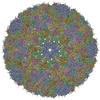

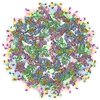
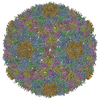
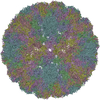
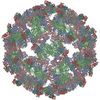
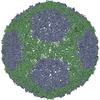
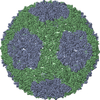


 Z (Sec.)
Z (Sec.) Y (Row.)
Y (Row.) X (Col.)
X (Col.)
























